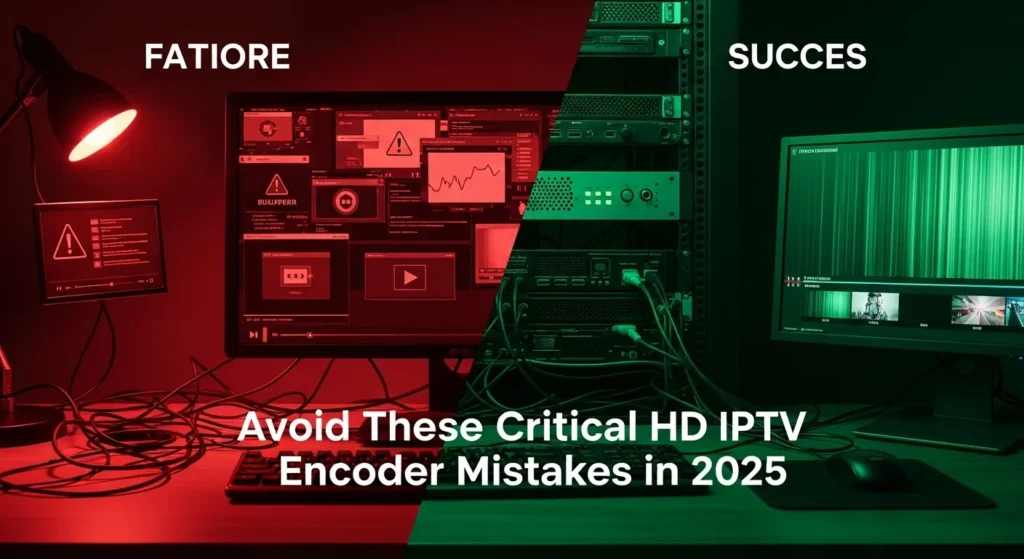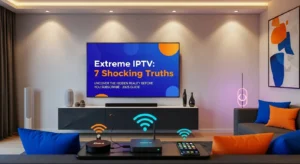Introduction – Why Avoiding Mistakes with HD Professional IPTV Encoder Encoders Is Critical
HD professional IPTV encoder encoders represent the backbone of modern streaming infrastructure, yet countless broadcasters and IPTV resellers make costly mistakes that lead to poor streaming performance, viewer churn, and wasted investments. With the streaming landscape evolving rapidly in 2025, selecting the wrong encoder can spell disaster for your IPTV operation.
The stakes have never been higher. Modern viewers expect crystal-clear HD content with ultra-low latency streaming, and any technical hiccup can drive audiences to competitors. Whether you’re an IPTV reseller serving thousands of subscribers, a broadcaster launching new channels, or a content creator building your streaming empire, understanding common encoder pitfalls is essential for success.
This comprehensive IPTV setup guide will walk you through the five most critical mistakes professionals make when selecting and deploying HD IPTV encoders, helping you avoid the technical debt and operational headaches that plague poorly planned streaming infrastructures.
Table of Contents
What Makes an Encoder “Professional” vs. Consumer-Grade
Before diving into common mistakes, it’s crucial to understand what separates professional-grade encoders from consumer alternatives. This distinction often determines whether your streaming operation succeeds or fails under real-world conditions.hd professional iptv encoder encoders
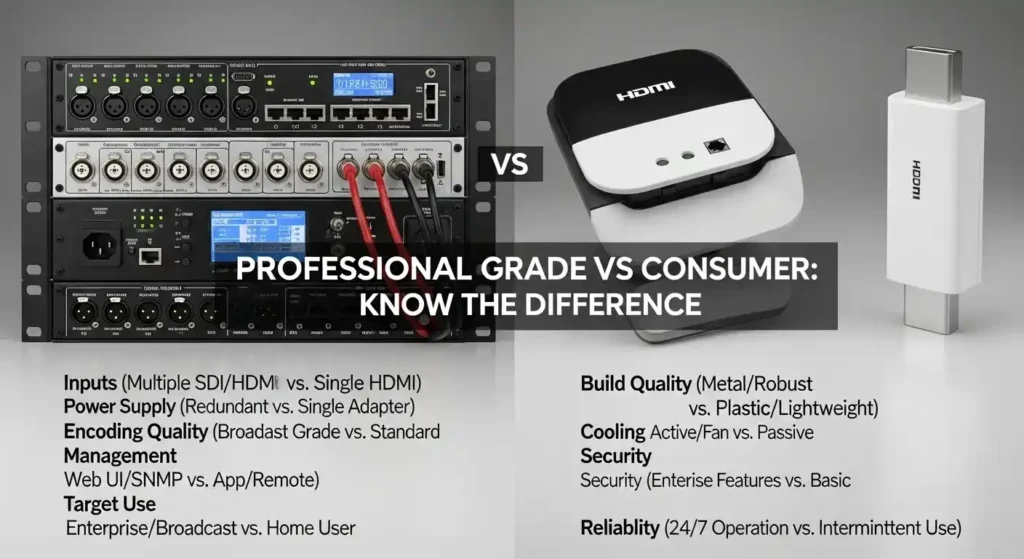
Professional Encoder Characteristics
Professional HD encoders feature robust hardware architectures designed for 24/7 operation, multiple redundant power supplies, and enterprise-grade cooling systems. They typically include dedicated encoding chips or FPGA processors that handle video signal capture and real-time encoding without dropping frames during peak loads.hd professional iptv encoder encoders
Key professional features include:
- Multiple simultaneous encoding profiles for adaptive bitrate streaming
- Support for broadcast-grade inputs (3G-SDI, HDMI with embedded audio)
- Network redundancy with dual Ethernet ports
- SNMP monitoring and API control interfaces
- Hardware-based encoding acceleration
- Temperature and voltage monitoring systems
Consumer-Grade Limitations
Consumer encoders, while cost-effective, often lack the reliability and feature set required for professional deployments. They may use software-based encoding that struggles under load, offer limited input options, and lack the monitoring capabilities essential for maintaining service quality.
The performance gap becomes apparent during high-stress scenarios: peak viewing periods, network congestion, or hardware failures. Professional encoders maintain consistent output quality, while consumer units may drop frames, introduce artifacts, or fail entirely.hd professional iptv encoder encoders
Technical Specs That Often Cause Problems
Codec Issues: The H.264 vs. H.265/HEVC Dilemma
One of the most common IPTV encoder errors stems from codec selection mismatches. Many operators assume newer H.265/HEVC encoding automatically provides better results, but this creates significant compatibility and processing challenges.hd professional iptv encoder encoders
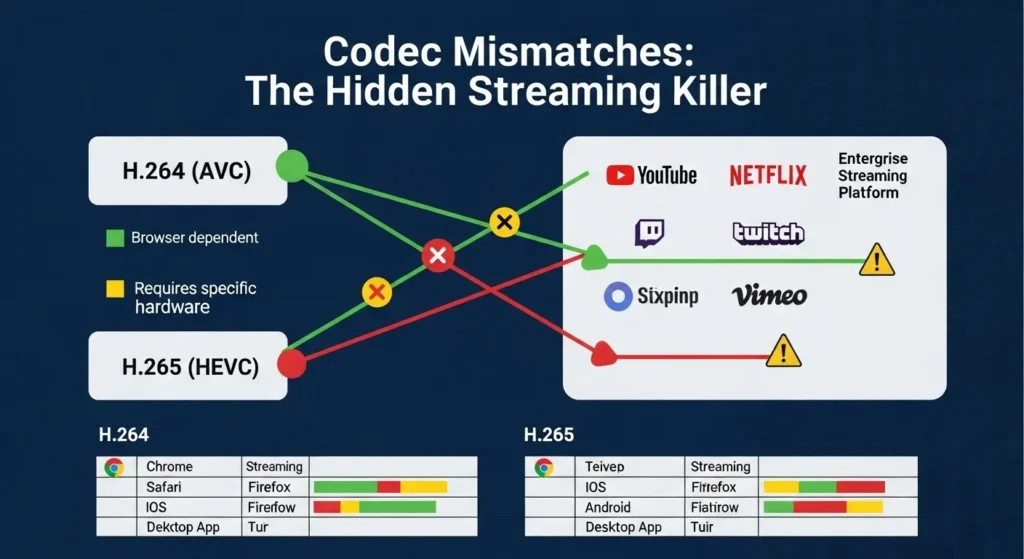
H.264 Advantages:
- Universal device compatibility across all streaming platforms
- Lower encoding latency ideal for live broadcasts
- Reduced computational requirements for real-time processing
- Proven stability in multi-protocol broadcast environments
H.265/HEVC Considerations:
- 50% bandwidth savings compared to H.264 at equivalent quality
- Increased encoding complexity requiring more powerful hardware
- Limited compatibility with older streaming devices
- Higher licensing costs and patent complexity
The critical mistake many make is deploying H.265 without thoroughly testing end-device compatibility. While bandwidth savings are attractive, alienating viewers with incompatible devices defeats the purpose.hd professional iptv encoder encoders
Multi-Streaming Misconfigurations
Professional IPTV operations require simultaneous delivery across multiple protocols and platforms. Common bitrate misconfiguration issues include:
Profile Mismatch Problems:
- Creating too many encoding profiles that overwhelm hardware resources
- Insufficient bitrate allocation for higher resolution streams
- Misaligned keyframe intervals causing synchronization issues
- Incompatible audio codec selections across different outputs
Protocol-Specific Challenges: Different streaming protocols have unique requirements that must be considered during encoder configuration:
- RTMP: Requires consistent keyframe intervals and specific audio settings
- HLS: Demands proper segment duration and manifest file generation
- SRT: Needs careful latency and packet recovery parameter tuning
Input/Output Interface Mismatches
Video signal capture problems often stem from interface incompatibilities that aren’t discovered until deployment. Professional encoders typically offer multiple input types, but each has specific requirements and limitations.
HDMI Interface Considerations:
- HDCP copy protection can block signal capture
- Resolution and refresh rate limitations vary by HDMI version
- Audio embedding may not work consistently across all sources
- Cable length restrictions for reliable signal transmission
SDI Interface Benefits:
- Professional broadcast standard with guaranteed signal integrity
- Embedded time code and metadata support
- Long-distance transmission capabilities without degradation
- Frame-accurate synchronization for multi-camera productions
The mistake many operators make is assuming HDMI provides equivalent functionality to SDI for professional applications. While HDMI works for basic scenarios, SDI offers the reliability and features essential for broadcast-quality productions.
Top 5 Critical Mistakes Broadcasters Make
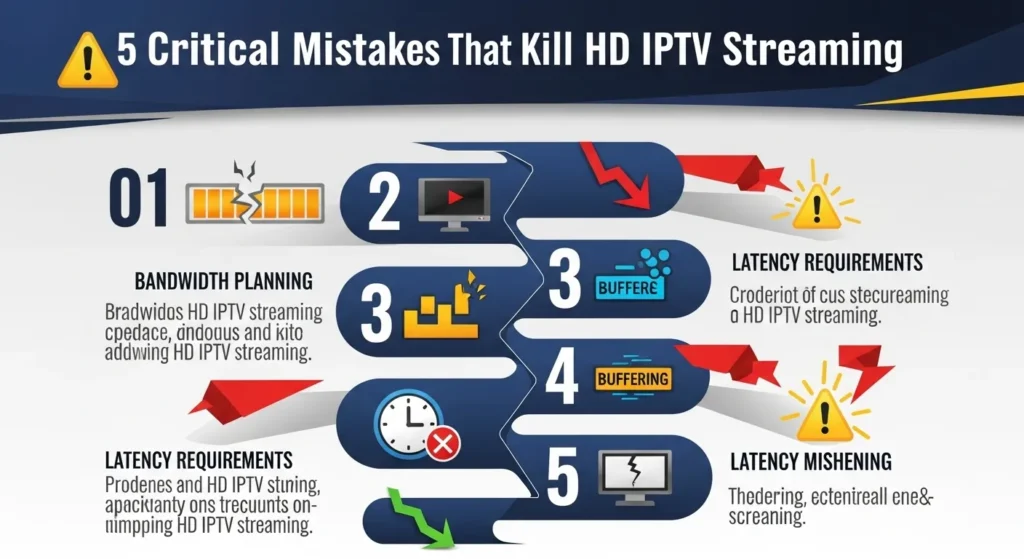
Mistake #1: Inadequate Bandwidth Planning
The most devastating mistake involves underestimating bandwidth requirements for HD professional IPTV encoder encoders. Many operators calculate bandwidth needs based on theoretical maximums without accounting for real-world variables.
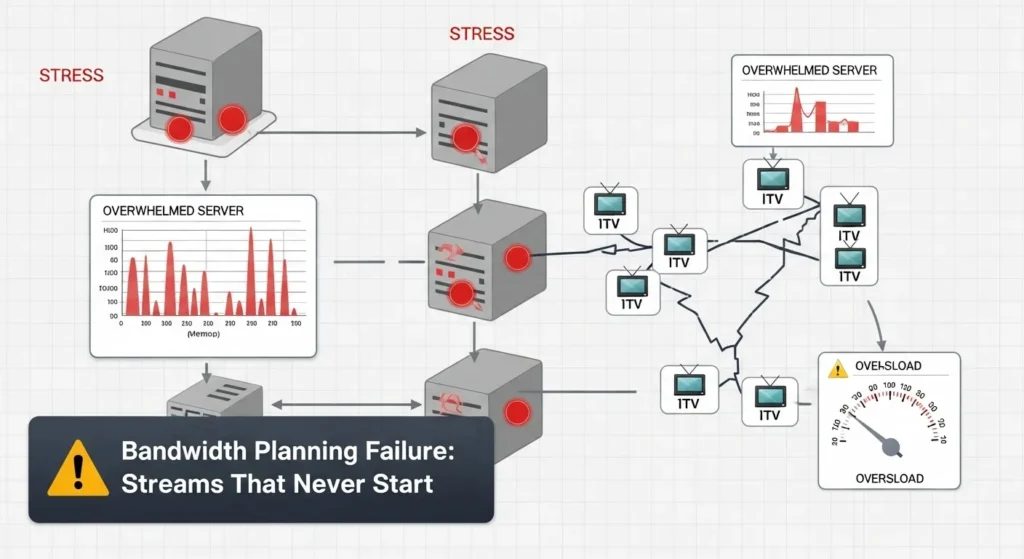
Common Planning Errors:
- Using peak bitrate instead of average for capacity calculations
- Ignoring overhead from streaming protocol encapsulation
- Failing to account for redundancy and failover requirements
- Underestimating concurrent viewer peaks during popular events
Real-World Impact: A broadcaster configured their encoder for 5 Mbps average bitrate but experienced regular stream failures during sports events when actual bitrate peaked at 8 Mbps, causing buffer underruns and viewer complaints.
Solution: Always plan for 150-200% of calculated bandwidth requirements and implement adaptive bitrate streaming to handle network congestion gracefully.hd professional iptv encoder encoders
Mistake #2: Ignoring Latency Requirements
Live streaming pitfalls often center around latency mismanagement. Different applications have varying latency tolerances that must be considered during encoder selection and configuration.hd professional iptv encoder encoders
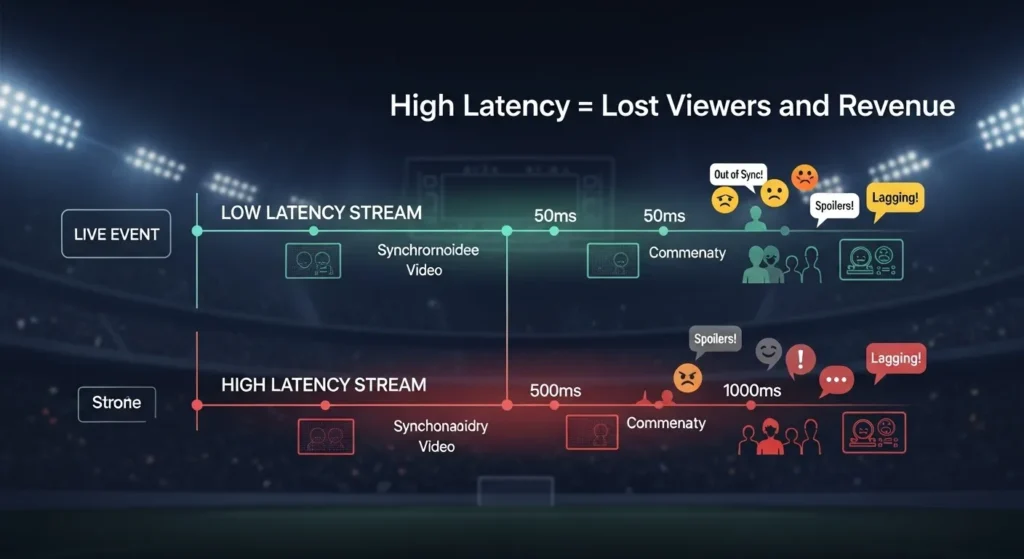
Latency Categories:
- Ultra-low latency (sub-second): Interactive applications, live betting, real-time communication
- Low latency (2-5 seconds): Live sports, news broadcasts, gaming streams
- Standard latency (10-30 seconds): General entertainment content, recorded shows
Configuration Errors: Many operators enable every available feature without understanding the latency implications. Each processing step adds delay: deinterlacing, noise reduction, logo insertion, and multi-protocol output all contribute to end-to-end latency.
Mistake #3: Poor Redundancy Planning
Stream redundancy failures represent catastrophic risks for professional IPTV operations. Single points of failure can bring down entire streaming services, causing subscriber churn and revenue loss.
Critical Redundancy Elements:
- Dual power supplies with automatic failover
- Network interface redundancy with load balancing
- Encoder hardware redundancy with hot-standby configuration
- Multiple upstream internet connections from different providers
Implementation Mistakes:
- Relying on single encoder units without backup systems
- Using the same network infrastructure for primary and backup streams
- Inadequate monitoring systems that don’t detect failures quickly enough
- Missing automated failover procedures requiring manual intervention
Mistake #4: Insufficient Testing and Validation
Many operators deploy encoders after basic functionality tests without comprehensive validation under realistic conditions. This approach leads to problems during live operations when fixing issues becomes exponentially more difficult and expensive.
Essential Testing Scenarios:
- Peak concurrent viewer load testing
- Network congestion simulation and recovery
- Hardware failure scenarios and failover timing
- Extended duration stress testing (24-48 hour continuous operation)
- Multi-protocol output validation across different devices. hd professional iptv encoder encoders.
Mistake #5: Inadequate Monitoring and Alerting
Professional IPTV operations require comprehensive monitoring systems that detect problems before they impact viewers. Many operators implement basic monitoring but miss critical metrics that indicate impending failures.
Essential Monitoring Parameters:
- Encoder hardware temperature and fan speed
- Network utilization and packet loss rates
- Stream bitrate variation and quality metrics
- Audio/video synchronization accuracy
- Upstream connectivity status and bandwidth utilization
Real-World Consequences of Poor Encoder Choices
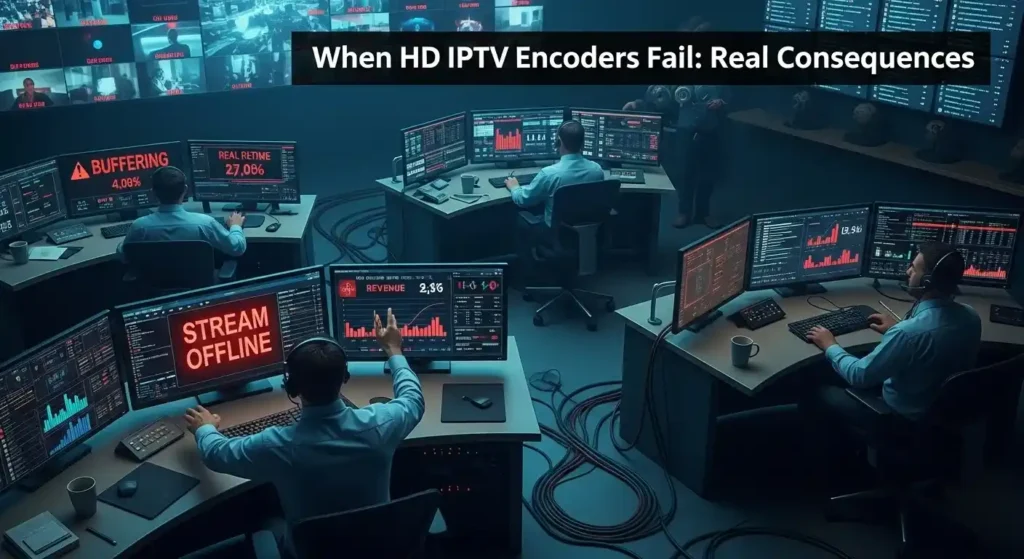
Case Study: Regional Sports Network Failure
A regional sports broadcaster selected consumer-grade encoders to reduce initial costs for their new IPTV service. During the first major game broadcast, multiple encoders overheated under load, causing widespread service outages during peak viewership. hd professional iptv encoder encoders.
Financial Impact:
- $50,000 in subscriber refunds and credits
- $25,000 in emergency equipment replacement costs
- $75,000 in lost advertising revenue from interrupted broadcasts
- Immeasurable damage to brand reputation and viewer trust
Technical Lessons: The consumer encoders lacked adequate cooling systems and proper thermal management for sustained high-bitrate encoding. Professional encoders with redundant cooling would have prevented the failures.
Case Study: IPTV Reseller Bandwidth Crisis
An IPTV reseller misconfigured their HD professional IPTV encoder encoders with excessive bitrates, causing bandwidth costs to spiral out of control while simultaneously creating buffering issues for subscribers on limited connections.
The Problem:
- Configured all streams at maximum 10 Mbps bitrate
- No adaptive bitrate streaming implementation
- Insufficient CDN capacity planning
- Poor understanding of subscriber connection capabilities
Resolution Strategy: Implementation of proper adaptive bitrate streaming with multiple encoding profiles (2 Mbps, 4 Mbps, 6 Mbps, 8 Mbps) reduced bandwidth costs by 60% while improving viewer experience across diverse connection types.
How to Test and Validate Your HD Professional IPTV Encoder Encoders Before Deployment
Pre-Deployment Testing Protocol
Comprehensive testing prevents costly mistakes and ensures reliable operation from day one. This systematic approach identifies potential issues before they impact live services.
Hardware Validation Steps:
- Thermal Stress Testing
- Run encoders at maximum settings for 48 continuous hours
- Monitor temperature sensors and fan speeds throughout testing
- Verify automatic thermal protection systems function correctly
- Document performance degradation at elevated temperatures
- Input Signal Compatibility
- Test all supported input formats and resolutions
- Verify HDCP handling and bypass capabilities
- Validate audio embedding and extraction accuracy
- Check signal detection and automatic format switching
- Network Performance Validation
- Test maximum concurrent stream output capabilities
- Verify network interface redundancy and failover timing
- Measure actual throughput versus theoretical specifications
- Validate SNMP monitoring and alerting functionality
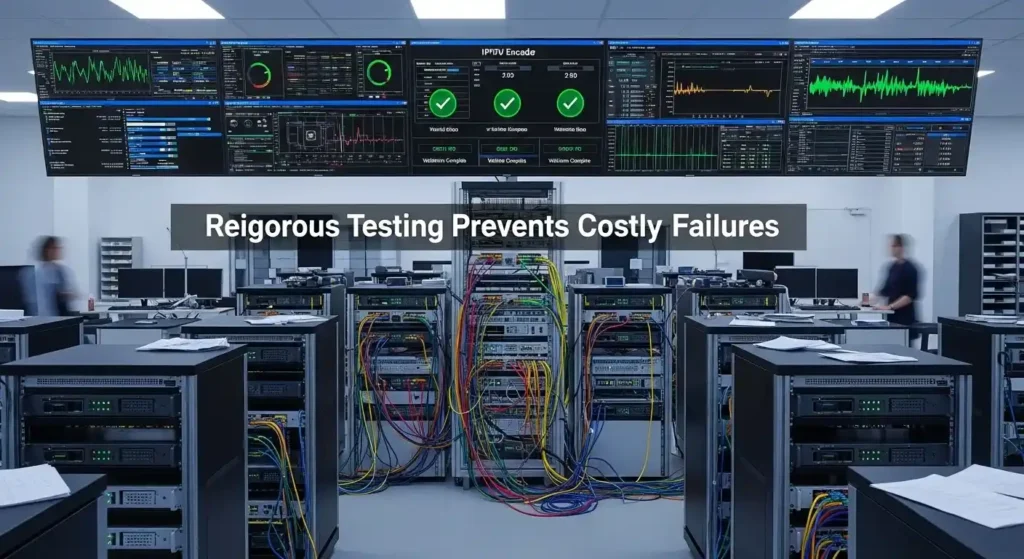
Software and Configuration Testing
Encoding Quality Assessment: Objective quality measurement ensures consistent output across different content types and scenarios. hd professional iptv encoder encoders.
- Use standardized test patterns and real-world content samples
- Measure PSNR (Peak Signal-to-Noise Ratio) and SSIM (Structural Similarity Index)
- Test motion-heavy content like sports and fast-paced action sequences
- Validate color space conversion accuracy and bit depth preservation
Multi-Protocol Output Verification: Different streaming protocols require specific testing approaches to ensure compatibility and performance.
- RTMP Testing: Verify keyframe alignment and audio synchronization
- HLS Validation: Check segment generation timing and manifest accuracy
- SRT Assessment: Test packet recovery and latency consistency
- MPEG-DASH: Validate fragment timing and adaptive bitrate switching
Load Testing and Scalability Assessment
Concurrent Stream Testing: Professional encoders must handle multiple simultaneous outputs without performance degradation. hd professional iptv encoder encoders.
Testing matrix should include:
- Maximum advertised stream count at various quality settings
- Mixed resolution output scenarios (HD, 4K, multiple bitrates)
- Different codec combinations running simultaneously
- Network congestion scenarios with adaptive response validation
Cost and ROI Implications of Bad Decisions
Total Cost of Ownership Analysis
Initial purchase price represents only a fraction of encoder lifecycle costs. Poor initial choices create ongoing operational expenses that quickly exceed savings from cheaper equipment.
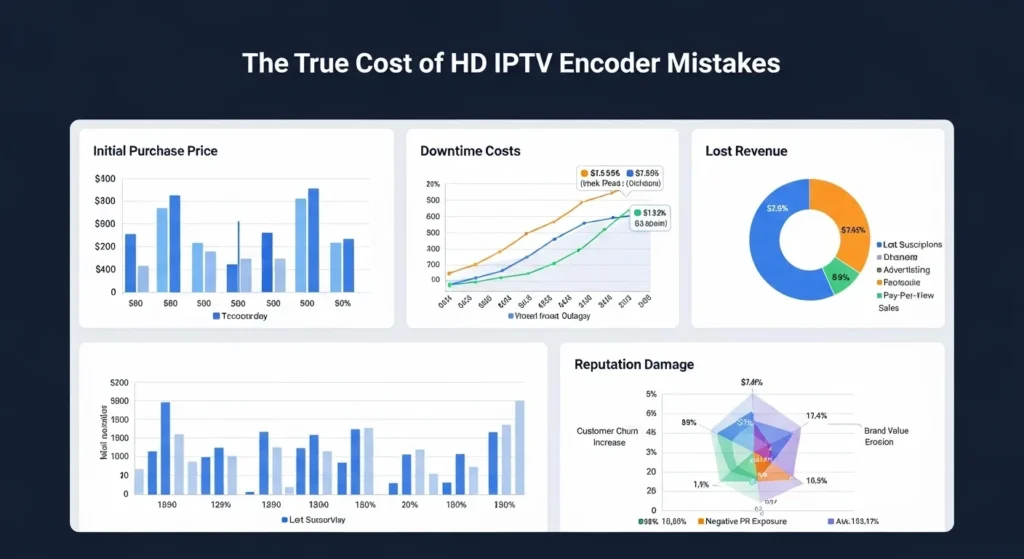
Direct Cost Components:
- Hardware purchase and initial configuration
- Ongoing bandwidth and CDN costs
- Maintenance and support contracts
- Power consumption and cooling requirements
- Staff time for monitoring and troubleshooting
Hidden Cost Factors:
- Subscriber churn from poor streaming quality
- Emergency replacement costs during failures
- Lost advertising revenue from service interruptions
- Technical support overhead for viewer complaints
- Legal and compliance issues from service level agreement violations
ROI Calculation Framework
Revenue Impact Analysis: Quality encoders directly impact revenue through improved viewer retention and reduced support costs.
- Subscriber Retention: Professional-grade streaming reduces churn by 15-25%
- Premium Service Tiers: Higher quality enables premium pricing strategies
- Operational Efficiency: Automated monitoring reduces staffing requirements
- Scalability Benefits: Professional encoders handle growth without major infrastructure changes
Cost-Benefit Example: A mid-sized IPTV operator with 10,000 subscribers comparing consumer vs. professional encoders:
Consumer Option (Initial Cost: $5,000):
- Annual churn rate: 35%
- Support costs: $15,000/year
- Bandwidth waste: $8,000/year
- Emergency repairs: $3,000/year
Professional Option (Initial Cost: $15,000):
- Annual churn rate: 20%
- Support costs: $8,000/year
- Optimized bandwidth: -$2,000/year savings
- Emergency repairs: $500/year
Three-year ROI: Professional encoders provide $45,000 additional value despite higher initial cost.
Recommended Models and Safe Choices for 2025
Enterprise-Grade HD Professional IPTV Encoder Encoders
High-Performance Category (>$10,000):
Professional broadcasters requiring maximum reliability and features should consider enterprise solutions with redundant components and comprehensive management capabilities. hd professional iptv encoder encoders.
Key features to prioritize:
- Dual power supplies with automatic failover
- Hot-swappable components for zero-downtime maintenance
- Comprehensive SNMP monitoring and API control
- Multi-protocol simultaneous output (RTMP, HLS, SRT, MPEG-DASH)
- Hardware-accelerated encoding with dedicated processing chips
Mid-Range Professional Category ($3,000-$10,000):
Ideal for IPTV resellers and medium-scale operations requiring professional features without enterprise overhead. hd professional iptv encoder encoders.
Essential capabilities:
- Reliable 24/7 operation with proper thermal management
- Multiple encoding profiles with adaptive bitrate support
- Professional input options (SDI, HDMI with bypass)
- Network redundancy and failover capabilities
- Remote monitoring and configuration management
Validation Criteria for Encoder Selection
Performance Benchmarks:
- Sustained encoding performance under thermal stress
- Network throughput consistency across all output protocols
- Audio/video synchronization accuracy within broadcast tolerances
- Stream startup time and channel switching responsiveness
Reliability Indicators:
- MTBF (Mean Time Between Failures) ratings from independent testing
- Temperature operating ranges with performance specifications
- Power consumption efficiency and cooling requirements
- Warranty terms and manufacturer support responsiveness
Future-Proofing Considerations
Technology Evolution Trends
The streaming landscape continues evolving rapidly, requiring encoder investments that remain viable for 3-5 year lifecycles. hd professional iptv encoder encoders.
Emerging Codec Standards:
- AV1 codec adoption for next-generation efficiency
- HDR (High Dynamic Range) content support requirements
- 4K/8K resolution capabilities for premium services
- Variable bitrate optimization with AI-driven encoding
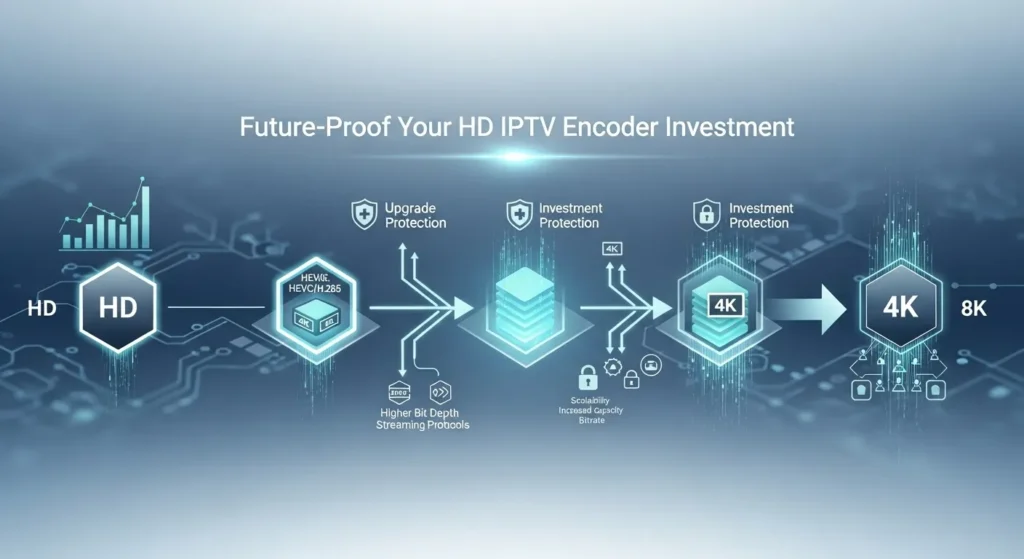
Network Infrastructure Evolution:
- 5G network optimization for mobile streaming
- Edge computing integration for latency reduction
- IPv6 transition requirements and dual-stack support
- Cloud-based encoding and hybrid deployment models. hd professional iptv encoder encoders.
Investment Protection Strategies
Modular Architecture Benefits: Choose encoders with upgradeable components and expandable capabilities:
- Software-defined features enabled through licensing
- Hardware modules for additional input/output options
- Firmware updates providing new codec and protocol support
- API compatibility for third-party integration and automation
Vendor Ecosystem Considerations:
- Long-term manufacturer viability and support commitment
- Third-party integration partnerships and ecosystem breadth
- Open standards compliance preventing vendor lock-in
- Migration path availability for future technology transitions
Conclusion – How to Avoid Mistakes and Ensure Flawless HD Streaming
Successfully deploying HD professional IPTV encoder encoders requires careful planning, comprehensive testing, and realistic assessment of operational requirements. The five critical mistakes outlined in this guide—inadequate bandwidth planning, latency mismanagement, poor redundancy design, insufficient testing, and inadequate monitoring—account for the majority of streaming operation failures.
Professional success depends on understanding that encoders represent the foundation of your entire streaming infrastructure. Cutting corners on encoder selection and deployment inevitably leads to operational headaches, increased costs, and subscriber dissatisfaction that can take years to overcome.
The investment in professional-grade equipment and proper deployment practices pays dividends through improved reliability, reduced operational overhead, and enhanced viewer satisfaction. As the IPTV landscape becomes increasingly competitive, operators who prioritize technical excellence and avoid these common pitfalls will build sustainable, profitable streaming businesses. hd professional iptv encoder encoders.
Remember that technology selection is just the beginning. Ongoing monitoring, regular maintenance, and continuous optimization ensure your HD IPTV encoders deliver consistent performance that keeps subscribers engaged and revenue growing. The streaming industry rewards operators who understand that technical excellence directly translates to business success. hd professional iptv encoder encoders.
For more comprehensive IPTV setup guidance and technical resources, consider consulting with experienced video delivery specialists who can provide customized recommendations based on your specific operational requirements and growth objectives. The cost of expert consultation pales in comparison to the expenses and reputation damage caused by avoidable technical mistakes. hd professional iptv encoder encoders.

